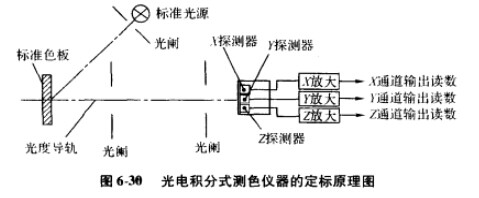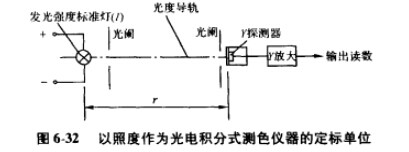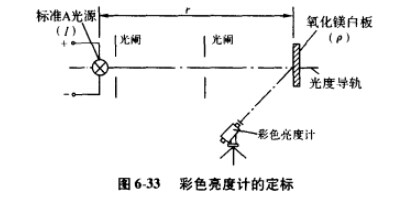1. Instrument Calibration Principle of Photoelectric Integral Colorimeter (1) The spectral response of the three photodetectors of the colorimeter are respectively matched to x(λ), y(λ), z(λ) curves. Some photoelectric integral colorimeter probes are designed with a flat receiving surface. In such cases, the Y channel can be calibrated by illumination. As shown in Figure 6-32, the Y channel acts as an illuminometer detector, and the instrument is calibrated and adjusted on the photometric guide using a luminous intensity standard lamp. The Y channel correction potentiometer adjusts the amplifier’s gain. 2. Application Examples (1) Calibration of the Color Luminance Meter When the illuminance of the magnesium oxide whiteboard surface is E, the brightness of the surface is L = PE / Ï€. During calibration, the first step is to adjust the Y channel of the color luminance meter so that the displayed reading equals Lâ‚€. Usually, the distance between the standard lamp and the standard whiteboard is adjusted to ensure that L = 100 cd/m², making the calibration easier. Then, adjust the corresponding Xâ‚ and Z channels to make the tristimulus values Xâ‚, Y, Z match the calculated tristimulus values of the magnesium oxide whiteboard under the CIE Standard Light Source A. PET Braided Pattern Sleeve is a protective covering or sleeve made from braided fabric or material that is designed to be worn by a pet. It is typically used to protect the pet's limbs or body in situations where they may be at risk of injury or abrasion. The braided design helps to provide flexibility and comfort for the pet while also offering a layer of protection. Pet braided sleeves are commonly used in situations such as post-surgery recovery, wound healing, or for pets with skin conditions that require added protection. They can be easily put on and taken off, and are available in various sizes to fit different breeds and sizes of pets. PET Cable Protection Sleeve,Heat Protection Wire Sleeving,Hose Protection Sleeve Dongguan Liansi Electronics Co.,Ltd , https://www.liansisleeve.com



July 28, 2025